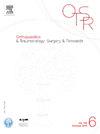Risk prediction of kalaemia disturbance and acute kidney injury after total knee arthroplasty: use of a machine learning algorithm
IF 2.3
3区 医学
Q2 ORTHOPEDICS
引用次数: 0
Abstract
Introduction
Total knee arthroplasty (TKA) is a procedure associated with risks of electrolyte and kidney function disorders, which are rare but can lead to serious complications if not correctly identified. A routine check-up is very often carried out to assess the seric ionogram and kidney function after TKA, that rarely requires clinical intervention in the event of a disturbance. The aim of this study was to identify perioperative variables that would lead to the creation of a machine learning model predicting the risk of kalaemia disorders and/or acute kidney injury after total knee arthroplasty.
Hypothesis
A predictive model could be constructed to estimate the risk of kalaemia disorders and/or acute kidney injury after total knee arthroplasty.
Material and methods
This single-centre retrospective study included 774 total knee arthroplasties (TKA) operated on between January 2020 and March 2023. Twenty-five preoperative variables were incorporated into the machine learning model and filtered by a first algorithm. The most predictive variables selected were used to construct a second algorithm to define the overall risk model for postoperative kalaemia and/or acute kidney injury (K+ A). Two groups were formed of K+ A and non-K+ A patients after TKA. A univariate analysis was performed and the performance of the machine learning model was assessed by the area under the curve representing the sensitivity of the model as a function of 1 - specificity.
Results
Of the 774 patients included who had undergone TKA surgery, 46 patients (5.9%) had a postoperative kalaemia disorder requiring correction and 13 patients (1.7%) had acute kidney injury, of whom 5 patients (0.6%) received vascular filling. Eight variables were included in the machine learning predictive model, including body mass index, age, presence of diabetes, operative time, lowest mean arterial pressure, Charlson score, smoking and preoperative glomerular filtration rate.
Overall performance was good with an area under the curve of 0.979 [CI95% 0.938–1.02], sensitivity was 90.3% [CI95% 86.2–94.4] and specificity 89.7% [CI95% 85.5–93.8]. The tool developed to assess the risk of impaired kalaemia and/or acute kidney injury after TKA is available on https://arthrorisk.com.
Conclusion
The risk of kalaemia disturbance and postoperative acute kidney injury after total knee arthroplasty could be predicted by a model that identifies low-risk and high-risk patients based on eight pre- and intraoperative variables. This machine learning tool is available on a web platform accessible for everyone, easy to use and has a high predictive performance. The aim of the model was to better identify and anticipate the complications of dyskalaemia and postoperative acute kidney injury in high-risk patients. Further prospective multicentre series are needed to assess the value of a systematic postoperative biochemical work-up in the absence of risk predicted by the model.
Level of evidence
IV; retrospective study of case series.
全膝关节置换术后钾血症紊乱和急性肾损伤的风险预测:使用机器学习算法。
导言:全膝关节置换术(TKA)是一种存在电解质和肾功能紊乱风险的手术,这种风险虽然罕见,但如果不能正确识别,可能会导致严重的并发症。TKA 术后通常会进行常规检查以评估血清离子图和肾功能,一旦出现紊乱,很少需要进行临床干预。本研究的目的是确定围手术期的变量,从而建立一个机器学习模型,预测全膝关节置换术后出现贫血症和/或急性肾损伤的风险:假设:可以构建一个预测模型来估算全膝关节置换术后出现贫血症和/或急性肾损伤的风险:这项单中心回顾性研究纳入了2020年1月至2023年3月期间进行的774例全膝关节置换术(TKA)。25个术前变量被纳入机器学习模型,并通过第一种算法进行筛选。筛选出的最具预测性的变量被用于构建第二种算法,以确定术后贫血和/或急性肾损伤(K+ A)的总体风险模型。将 TKA 术后出现 K+ A 和未出现 K+ A 的患者分为两组。进行了单变量分析,并通过代表模型灵敏度的曲线下面积与 1 - 特异性的函数关系评估了机器学习模型的性能:在纳入的 774 名接受过 TKA 手术的患者中,46 名患者(5.9%)术后出现了需要纠正的贫血症,13 名患者(1.7%)出现了急性肾损伤,其中 5 名患者(0.6%)接受了血管充盈治疗。机器学习预测模型包含八个变量,包括体重指数、年龄、是否患有糖尿病、手术时间、最低平均动脉压、Charlson 评分、吸烟和术前肾小球滤过率。总体性能良好,曲线下面积为 0.979 [CI95% 0.938 - 1.02],灵敏度为 90.3% [CI95% 86.2 - 94.4],特异性为 89.7% [CI95% 85.5 - 93.8]。为评估 TKA 术后出现低钾血症和/或急性肾损伤的风险而开发的工具可在 https://arthrorisk.com.Conclusion 上查阅:全膝关节置换术后出现血钾紊乱和术后急性肾损伤的风险可通过一个模型进行预测,该模型可根据术前和术中的八个变量识别低风险和高风险患者。这种机器学习工具可在网络平台上使用,人人都能访问,使用方便,预测性能高。该模型的目的是更好地识别和预测高危患者的失调血症和术后急性肾损伤并发症。需要进一步开展前瞻性多中心系列研究,以评估在该模型未预测风险的情况下,系统性术后生化检查的价值:证据级别:IV;病例系列回顾性研究。
本文章由计算机程序翻译,如有差异,请以英文原文为准。
求助全文
约1分钟内获得全文
求助全文
来源期刊
CiteScore
5.10
自引率
26.10%
发文量
329
审稿时长
12.5 weeks
期刊介绍:
Orthopaedics & Traumatology: Surgery & Research (OTSR) publishes original scientific work in English related to all domains of orthopaedics. Original articles, Reviews, Technical notes and Concise follow-up of a former OTSR study are published in English in electronic form only and indexed in the main international databases.

 求助内容:
求助内容: 应助结果提醒方式:
应助结果提醒方式:


